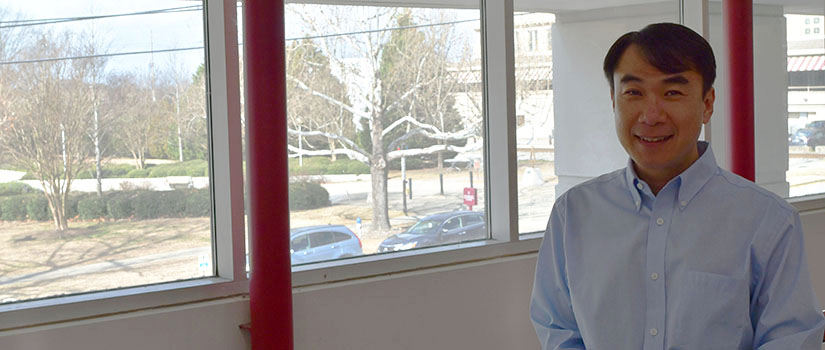Road and bridge construction projects are a vital component of South Carolina’s commerce and economy. But many projects experience delays and cost overruns like long permit approval processes or material and equipment shortages before they even get started. These delays impact travelers with increased traffic and accidents in and around construction zones. Civil and Environmental Engineering Professor Nathan Huynh is currently expanding his initial research and development of web apps to alleviate these pre-construction issues and get traffic moving.
Huynh’s research, “Streamlining Permitting and Mitigation Processes to Improve SCDOT Project Delivery,” is a three-year, $442,281 project funded by the South Carolina Department of Transportation (SCDOT) and the Federal Highway Administration. The co-principal investigators are Civil and Environmental Engineering Assistant Professor Erfan Goharian and Computer Science and Engineering Professor Jose Vidal.
The research is the second phase of a previous three-year grant in which Huynh’s team developed four web apps for the SCDOT. In this phase, the team hopes to enhance the current capabilities and functionalities of the apps, which have led to decreased risks and a faster permit approval process.
“We'll provide maintenance and support to the apps we’ve already developed by adding reporting capabilities and integrating them with the existing tools,” Huynh says. “The apps help the SCDOT streamline their processes long term. Their emphasis has always been to have a tool to use in day-to-day operations with meaningful benefits, improving project deliveries, and saving taxpayers money.”
Prior to Huynh’s initial research, a tool developed by the Massachusetts DOT had the appeal and functionality that the SCDOT desired. The SCDOT asked Huynh’s research team to develop similar web apps tailored to their needs, which included jurisdictional determination, project screening, mitigation forecasting and general permits.
The first app for jurisdictional determination decides if a SCDOT project will impact water, wetlands or endangered species habitats that require U.S. Army Corps of Engineers approval. The current paper-based process using different consultants is susceptible to errors and confusion.
“Having a map from different general permit applications with the same symbology was a no brainer for the SCDOT. The U.S. Army Corps of Engineers will know exactly what they’re looking at,” Huynh says. “Different consultants presenting their maps with different symbols is currently happening, which leads to delays in reviews and approvals.”
The second app for project screening identifies critical red flags before applying for a permit so engineers can develop a design that minimizes impacts to South Carolina’s natural and human environment. The U.S. Army Corps of Engineers has authority over all road or bridge projects and must give approval before construction can begin. Completing a general permit application used to take 15 to 20 hours of data entry, but the app has reduced that time to approximately one hour.
“This app reduces time and increases SCDOT’s productivity. A desktop screening of limited datasets, which previously took four to six hours, now analyzes more than 100 datasets in just a few minutes and yields consistent results among all users,” Huynh says.
The third mitigation forecasting tool aims to reduce the number of projects at risk due to the lack of wetland and stream mitigation bank credit coverage. The app helps the SCDOT be transparent with financial institutions about the projected statewide stream and wetland impacts by having appropriate mitigations already in place when needed.
“If the SCDOT wants to build a road through a wetlands area that’s taking away a natural resource, the federal government requires compensation for that impact by creating the same type of environment to replace what’s being lost,” Huynh says. “This level of transparency removes several identified risk factors for the banking community. The bankers will now know which watersheds are critical and size their mitigation appropriately to deliver the required credits.”
Finally, the permit app helps the SCDOT streamline and standardize general permit application submissions. The process is currently inconsistent due to the diverse practice of consultants on contract.
“The app can auto-populate GPS coordinates, districts, cities and counties, and warning messages display when an incorrect or unexpected value is entered,” Huynh says. “With this app, a process that used to take 15 to 20 hours can now be completed in approximately one hour. It typically takes the U.S. Army Corps of Engineers between four and eight months before giving approval, but we anticipate the new process will shorten the time to within two months,” Huynh says.
The SCDOT currently uses two of the web apps, which reside on the College of Engineering and Computing’s server, but they will eventually migrate to their own server.
“From the start, the idea was to develop apps that the SCDOT could use immediately. Saving taxpayers money is essential, and the SCDOT wants to be a good steward of their money, which they receive from the gas tax,” Huynh says.
Other transportation agencies have taken note of these apps, and many aim to utilize the same technology to replace their current methods.
“The SCDOT has received a lot of recognition through our work. They mentioned the apps to their peers at conferences and other agencies in the region, who have asked how they work and if the SCDOT can share their tools. They are pretty proud of this project,” Huynh says.
Huynh enjoyed creating the apps and is looking forward to refining and improving their features, including building new ones such as for the National Environmental Policy Act. Huynh says that this research is more meaningful than a report that may not have any tangible benefits for the sponsor.
“The SCDOT and us want to leave a legacy,” Huynh says. “Years from now, it would be great for people at SCDOT headquarters to look back and see how these tools really changed their processes for the better and how it benefited the agency.”
